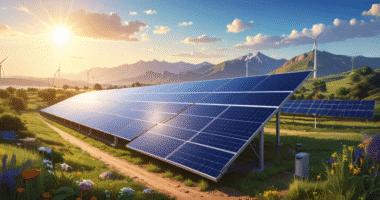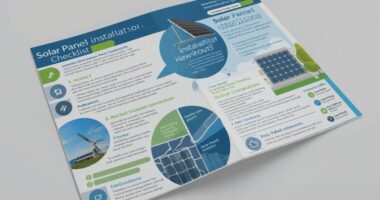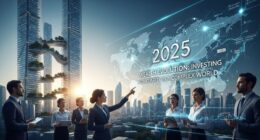The global renewable energy landscape is evolving rapidly in 2025. What was once a race to install as many solar panels and wind turbines as possible is now shifting toward a deeper, more strategic challenge: how to store and dispatch that energy reliably when and where it’s needed. In short: the deployment of renewables is entering the era of long-duration storage, grid integration, and system value.
According to the International Energy Agency (IEA), global renewable-electricity capacity is projected to rise dramatically between now and 2030, yet the report highlights that a lack of energy-storage and grid reliability is becoming the major bottleneck. IEA Meanwhile, global investment into renewables, grids, storage and low-emissions fuels in 2025 is expected to hit around US $2.2 trillion. World Economic Forum+2BloombergNEF+2
With this investment wave underway, the key question becomes: how can developers, utilities and policymakers shift focus from “how many gigawatts installed” to “how many hours of firm, dispatchable clean energy delivered”?
Below are the major shifts shaping this next phase of the clean-energy transition.
1. Why long-duration storage matters more than ever
As solar- and wind-power penetration increases, the old paradigm of “power when the sun shines or wind blows” is no longer sufficient. For renewables to truly replace fossil-fuel generation at scale, the system must deliver round the clock, not just during daytime or high-wind conditions. Experts now regard multi-hour or even multi-day storage as essential for system reliability.
In fact, a recent study shows that as deployment accelerates, the industry must transition from a build-out phase into a renewal-cycle phase — where replacement, recycling and longevity become critical. arXiv
Battery-energy storage systems (BESS) are rapidly scaling up, but cost declines, lifespan extension and integration with grid controls remain key. Categories such as flow batteries, hydrogen storage, thermal storage and advanced pumped-hydro are gaining traction.
From a business perspective, value is shifting from simply “megawatts installed” → “megawatt-hours delivered when needed”. Investors are increasingly sensitive to capacity factors, dispatchability and grid services revenue rather than pure size. This shift is changing project economics and risk profiles.
2. Emerging markets lead the way in storage + renewables
While developed markets have focused heavily on large-scale wind and solar builds, many emerging markets in Southeast Asia, Africa and Latin America are leap-frogging by adopting integrated storage + renewables hubs from the start. The logic is simple: their grids are weaker, reliability is lower, energy demand is rising fast and the economics of fossil generation are increasingly unfavourable.
For instance, small-scale solar plus battery micro-grids are becoming cost-competitive alternatives in remote-or rural-areas, reducing diesel dependence and improving resilience. The shift to decentralised models — rooftop solar, community storage, micro-grids — is now well underway. ratedpower.com
This has significant implications for companies and investors: first-mover advantage may now favour regions that embed storage and digital controls alongside generation. Second, supply chains for batteries, local assembly, installer networks and grid-services providers become critical.
3. Policy & investment realign toward dispatchability
The capital markets are responding. In first half of 2025, global investment in renewables hit record levels — around US $386 billion, up 10 % year-on-year. BloombergNEF Interestingly, much of that investment is moving toward smaller-scale solar, storage and hybrid systems, while utility-scale wind and solar saw some drop-off in financing in certain regions marked by policy uncertainty.
What this tells us: Investors view dispatchability, flexibility and system value as differentiators. Projects offering storage-backed, firm renewable power are commanding premium valuations and attracting higher volumes of capital. At the same time, policymakers are updating frameworks to reward storage, grid-services revenue and hybrid assets rather than just capacity. The 2025 trend map clearly shows digitalisation, storage, hydrogen and grid-integration rising to priority status. Deloitte+1
4. The technology stack is evolving: digital + storage + AI
The next phase of renewable deployment is not just about hardware—it’s about the smart orchestration of assets. Digital twins, AI-driven forecasting, predictive maintenance, virtual power plants (VPP), and grid-edge controls are becoming standard. While much of the attention previously focused on solar panels or wind turbines, the winning projects now integrate hardware + software + services.
This tech stack enhances storage utilisation (ensuring batteries are charged when surplus solar is available, discharged when needed most), improves reliability, reduces maintenance and extends asset life. Manufacturers, developers and asset owners who master this stack will have competitive advantage moving into the next decade.
5. Lifecycle & circular economy: the next industrial frontier
With capital moving fast and installations rising, we must also address the “what happens after 20-25 years” question. The industry is waking up to the fact that as assets age, the business shifts from new builds to repowering, recycling, second-life use of batteries or panels, and long-term performance optimisation. arXiv
Circular economy practices—such as reclaiming materials from decommissioned panels, repowering wind turbines with more efficient blades, repurposing batteries for grid-services once EV-grade capacity declines—are becoming key competitive differentiators. Companies embedding lifecycle management from day one will likely win the long game.
6. Key risks and how to manage them
Even as the opportunity set expands, risks proliferate. Developers and investors must pay attention to:
-
Grid-access and interconnection delays – Many new storage + renewables hubs face pig-tailing at the grid. Older grids struggle to absorb large amounts of variable power unless upgraded. ratedpower.com
-
Supply chain constraints – While battery and module costs are falling, raw material shortages, logistics bottlenecks and policy restrictions (e.g., around cobalt, lithium) remain a constraint.
-
Regulatory and market design lag – In many markets, rules favour simple generation assets; storage and hybrid models may still be undervalued or face market barriers.
-
Skills and workforce gap – The renewable sector needs a rapidly expanding skilled workforce to operate digital, smart platforms. worldwide-rs.com
-
Capital-cost inflation and financing risk – With rising interest rates in many markets, financing costs are climbing and project returns face pressure.
Addressing these risks means early coordination with grid operators, embedding smart controls, designing projects for flexibility and monetisation of grid-services, and thinking end-to-end from build to retirement.
7. Implications for Myanmar & ASEAN region
For nations like Myanmar and the wider Southeast Asian region, these global trends offer strong lessons and opportunities:
-
Design for value, not just capacity – Rather than purely chasing MWs, developers should focus on MWh of firm clean power delivered, which means pairing generation with storage and smart controls.
-
Promote decentralised + hybrid models – In regions where grid connectivity is weak or rural communities are off-grid, solar + storage micro-grids can deliver faster, cheaper and more resilient outcomes than large centralised plants.
-
Build local capability – Local manufacturing/assembly of storage modules, installer networks, maintenance services and digital controls will capture more value, reduce dependence on imports, and improve resilience.
-
Embed lifecycle thinking early – As assets age, preparing for repowering, recycling and second-life use will reduce total system cost and increase sustainability.
-
Leverage smart finance and policy frameworks – Governments and financiers should reward projects that deliver dispatchable clean power, not just capacity additions. Policy mechanisms should incentivise storage, grid-services, decentralised systems and end-to-end performance.
By aligning with global best practices while adapting to local conditions (land availability, grid readiness, demand growth), ASEAN and Myanmar can leapfrog into the next generation of renewables.
8. What comes next: the decade ahead
Looking ahead, the clean-energy transition of the 2020s arguably has two phases:
-
Phase 1 (2015–2025) = rapid build-out of solar & wind capacity.
-
Phase 2 (2025–2035) = system integration, storage, digitalisation, lifecycle management and global value-chain consolidation.
We are now firmly in Phase 2. Over the next five to ten years, winning projects will be those that: -
Deliver dispatchable clean power when needed, not just during peak hours.
-
Combine generation + storage + digital controls + lifecycle services.
-
Create local supply-chains, reduce import-dependence and embed circular-economy practices.
-
Participate in new revenue streams such as grid-services, hybrid fuel (e.g., hydrogen) production, and ancillary markets.
-
Mitigate risk via diversified technology, workforce capability and supply-chain resilience.
In short, the next frontier of renewable energy is not bigger solar farms or taller wind turbines—it is smarter, longer-lasting, and more value-dense systems. For investors, developers and policymakers who recognise this shift early, the opportunity is enormous.









